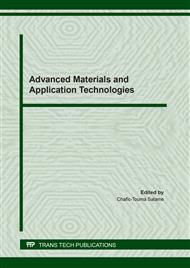[1]
X. L. Xu, X. S. Chen, Z. F. Wang and X. B. Jing, ultrafine PEG-PLA fibers loaded with both paclitaxel and doxorubicin hydrochloride and their in vitro cytotoxicity, Eur. J. Pharm. Biopharm., 72 (2009) 18–25.
DOI: 10.1016/j.ejpb.2008.10.015
Google Scholar
[2]
M. Ramalingam D. Rana, S. Ramakrishna, Nanofiber Composites for Biomedical Applications, first ed., Woodhead Publishing, Elsevier Ltd. (2017).
Google Scholar
[3]
G. Kim, S. M. Giannitelli, A. Rainer, K. H. T. Le, Y.J. Lee, M. Trombetta, Electrospinning of PCL/PVP blends for tissue engineering scaffolds, J. Mater. Sci.: Mater Med 24 (2013) 1425–1442.
DOI: 10.1007/s10856-013-4893-6
Google Scholar
[4]
J. Hu, M. P. Prabhakaran, and S. Ramakrishna, Drug-loaded emulsion electrospun nanofibers: characterization, drug release and in vitro biocompatibility, J. RSC. Adv. 5 (2015) 100256–100267.
DOI: 10.1039/c5ra18535a
Google Scholar
[5]
J. Hu, M. P. Prabhakaran, X. Ding, S. Ramakrishna, emulsion electrospinning of polycaprolactone: influence of the surfactant type towards the scaffolds properties, J. Biomater. Sci. Polym. Ed. 26 (2014) 57–75.
DOI: 10.1080/09205063.2014.982241
Google Scholar
[6]
T.T. Ruckh, R. Kumar, M.J. Kipper, K.C. Popat, Osteogenic differentiation of bone marrow stromal cells on poly(e-caprolactone) nanofiber scaffolds, Acta. Biomater. 6 (2010) 2949–2959.
DOI: 10.1016/j.actbio.2010.02.006
Google Scholar
[7]
W. L. Lee, P. Wee, C. Nugraha, S. C. J. Loo, J., Gastric-floating microcapsules provide controlled and sustained release of multiple cardiovascular drugs, Mater. Chem. B 1 ( 2013) 1090–1095.
DOI: 10.1039/c2tb00495j
Google Scholar
[8]
A. R. Jabur, E. S. Al-Hassani, A. M. Al-Shammari, M. A. Najim, A. A. Hassan, A. A. Ahmed, Evaluation of Stem Cells' Growth on Electrospun Polycaprolactone PCL) Scaffolds Used for Soft Tissue Applications, Energy Procedia, 119 (2017) 61-71.
DOI: 10.1016/j.egypro.2017.07.048
Google Scholar
[9]
L. Du, H. Xu, Y. Zhang, F. Zou, Electrospinning of Polycaprolatone Nanofibers with DMF Additive: The Effect of Solution Proprieties on Jet Perturbation and Fiber Morphologies, J. Fibers Polym. 17 (2016) 751-759.
DOI: 10.1007/s12221-016-6045-3
Google Scholar
[10]
G. R. Williams, B. T. Raimi-Abraham, C. J. Luo, Nanofibres in Drug Delivery, first ed., UCLPRES, London, 2018, p.37.
Google Scholar
[11]
X. Q. Li, Y. Su, X. Zhou, X. M. Mo, Distribution of sorbitan monooleate in poly(1-lactide –co-e-caprolactone) nanofibers from emulsion electrospinning, J. Colloids Surf. B 69 (2009)221–224.
DOI: 10.1016/j.colsurfb.2008.11.031
Google Scholar
[12]
M. Kurzawa, Determination of metoprolol tartrate by capillary isotachophoresis, Chem. Pap. 64 (2010) 294–300.
DOI: 10.2478/s11696-010-0002-1
Google Scholar
[13]
M. B. Clark, Jr. C. A. Burkhardt, J. A. Gardella, Surface studies of polymers. IV. An ESCA, IR and DSC study of the effect of homopolymer molecular weight on crystallinity and miscibility of poly (e-caprolactone)/poly (vinyl chloride) homopolymer blends, Macromolecules 24 (1991) 799–805.
DOI: 10.1021/ma00003a024
Google Scholar
[14]
N. M. Jalal, A. R. Jabur, M. S. Hamza, S. Allami, Sulfonated electrospun polystyrene as cation exchange membranes for fuel cells, Energy Reports 6 (2020) 287–298.
DOI: 10.1016/j.egyr.2019.11.012
Google Scholar
[15]
N. M. Jalal , A. R. Jabur1 , M. S.Hamza , S. Allami, Preparation, Microstructure and Morphology of Electrospun Sulfonated Polystyrene Films for Proton Exchange Membrane Hydrogen Fuel Cell, Technologies and Materials for Renewable Energy, Environment and Sustainability, TMREES18, 19–21 September 2018, Athens, Greece, Energy Procedia, 157, ( 2019), 1494-1505.
DOI: 10.1016/j.egypro.2018.11.314
Google Scholar
[16]
T.Y. Jasim, M.A. Najim, A.R. Jabur, Improving the mechanical properties of (chitosan /polyurethane) electrospun blend scaffold used for skin regeneration, AIP Conference Proceedings 2123, (2019) 020042.
DOI: 10.1063/1.5116969
Google Scholar


